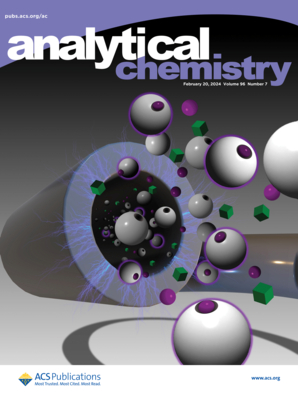Glycoproteomics Analysis to Identify Potential Biomarkers and Investigate CD14+ Monocyte Activation Mechanisms via Exosomal Proteins in Cerebral Infarction Using a Novel Glycogen-Functionalized Nanoprobe.
IF 6.7
1区 化学
Q1 CHEMISTRY, ANALYTICAL
引用次数: 0
Abstract
Cerebral infarction (CI) is a leading cause of disability and mortality, with activated plasma monocytes and altered protein glycosylation identified as critical contributors to its pathology. However, the mechanisms linking peripheral monocyte activation and glycoproteins in CI remain inadequately understood. In this study, we developed a glycogen-functionalized nanoprobe (mSiO2@Fe3O4@Glycogen) to profile plasma N-glycosylated proteins in healthy controls, CI patients, and patients in the rehabilitation phase (CIR). We identified 13 plasma N-glycoproteins with increased expression in CI patients and reduced levels in CIR patients. These N-glycoproteins, enriched in extracellular exosomes and associated with processes such as blood coagulation, fibrin clot formation, and complement activation, were validated as potential biomarkers for distinguishing CI and CIR patients through machine learning models. Flow cytometry analysis of peripheral blood mononuclear cells (PBMCs) revealed a higher proportion of inflammatory CD14+ monocytes and a lower proportion of anti-inflammatory CD16+ monocytes in CI patients compared with CIR patients. To further investigate whether exosomal proteins contribute to peripheral monocyte inflammation and could exacerbate CI pathogenesis, we developed a two-dimensional size-exclusion chromatography (SEC) method to isolate pure plasma exosomes for proteomic analysis. Four specific N-glycoproteins carried by CI-derived exosomes were identified and demonstrated the ability to directly activate human monocytes, potentially amplifying inflammation at injury sites. Our study highlights the role of exosomal N-glycoproteins in CI pathogenesis and positions them as promising diagnostic biomarkers and therapeutic targets for cerebral infarction.糖蛋白组学分析鉴定潜在的生物标志物和研究CD14+单核细胞激活机制,通过外泌体蛋白在脑梗死中使用新的糖原功能化纳米探针。
脑梗死(CI)是致残和死亡的主要原因,活化的血浆单核细胞和改变的蛋白糖基化被认为是其病理的关键因素。然而,连接外周单核细胞活化和糖蛋白在CI中的机制仍然不充分了解。在这项研究中,我们开发了一种糖原功能化的纳米探针(mSiO2@Fe3O4@Glycogen)来分析健康对照组、CI患者和康复期(CIR)患者的血浆n-糖基化蛋白。我们发现13种血浆n -糖蛋白在CI患者中表达增加,在CIR患者中表达降低。这些n -糖蛋白富集于细胞外外泌体中,与血液凝固、纤维蛋白凝块形成和补体激活等过程相关,通过机器学习模型被验证为区分CI和CIR患者的潜在生物标志物。外周血单核细胞(PBMCs)流式细胞术分析显示,与CIR患者相比,CI患者的炎性CD14+单核细胞比例较高,抗炎CD16+单核细胞比例较低。为了进一步研究外泌体蛋白是否有助于外周单核细胞炎症并可能加剧CI发病机制,我们开发了一种二维尺寸排除色谱(SEC)方法来分离纯血浆外泌体进行蛋白质组学分析。鉴定了ci衍生外泌体携带的四种特异性n糖蛋白,并证明了直接激活人类单核细胞的能力,可能会放大损伤部位的炎症。我们的研究强调了外泌体n -糖蛋白在CI发病机制中的作用,并将其定位为脑梗死有希望的诊断生物标志物和治疗靶点。
本文章由计算机程序翻译,如有差异,请以英文原文为准。
求助全文
约1分钟内获得全文
求助全文
来源期刊

Analytical Chemistry
化学-分析化学
CiteScore
12.10
自引率
12.20%
发文量
1949
审稿时长
1.4 months
期刊介绍:
Analytical Chemistry, a peer-reviewed research journal, focuses on disseminating new and original knowledge across all branches of analytical chemistry. Fundamental articles may explore general principles of chemical measurement science and need not directly address existing or potential analytical methodology. They can be entirely theoretical or report experimental results. Contributions may cover various phases of analytical operations, including sampling, bioanalysis, electrochemistry, mass spectrometry, microscale and nanoscale systems, environmental analysis, separations, spectroscopy, chemical reactions and selectivity, instrumentation, imaging, surface analysis, and data processing. Papers discussing known analytical methods should present a significant, original application of the method, a notable improvement, or results on an important analyte.
 求助内容:
求助内容: 应助结果提醒方式:
应助结果提醒方式:


